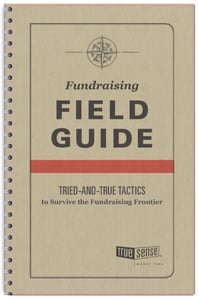
3 Fundraising Milestones: WIN, KEEP, and LIFT
The latest installment in an ongoing series of excerpts from The Fundraising Field Guide, by TrueSense Marketing.
Picture yourself running a small business. Let’s say it’s a donut shop. Besides making a profit, there are a number of basic questions to answer: How do I attract new customers? How do I get those customers back who have tried my donuts before, but have not returned? How do I interact with repeat customers and keep them coming back? How do I get my customers to buy more donuts?
In short, you are trying to WIN new customers (and win back previous ones), KEEP current customers, and LIFT customers to increase their purchases or come back more often.
The same thing can be said for your direct-response fundraising — minus the calories.
 WIN
WIN
WIN is really a two-pronged proposition: You can acquire new donors or reactivate those donors who haven’t given a gift in more than 13 months.
How do you WIN these new donors? Let’s take a look at the media channels used most often: direct mail, digital, telephone, newspapers, television, radio, face-to-face, special events, in-kind donations, and public collection points.
Note that media channels are becoming increasingly distinguished from response channels. Let’s use our donut shop example again. Mrs. Customer might see ads for your shop at a bus stop, on her social media channel, and on a website where she’s shopping. But she may actually respond — walk into the store with a smile and an appetite — when she gets a coupon from you in the mail.
The number of media channels available to us have also expanded over the years, but history has shown us that the single most cost-effective way to acquire new donors, in terms of volume and long-term value, is direct mail. Because it is the most common channel in direct-response fundraising, we’ll use it to demonstrate the principles of WIN.
Finding the right audience
Mailing to the right audience requires a secret sauce, which needs to be discovered through testing. Different organizations with different missions appeal to different kinds of donors — and each combination is somewhat unique.
In the direct-response world, list owners make their lists available for rent by qualified nonprofit organizations. And list brokers counsel those organizations to ensure that their list strategy is having the greatest impact, using their expertise and experience with other nonprofits. Brokers also negotiate list costs with owners on behalf of the organization. Depending on the size of your organization, they may suggest as few as 10 list rentals, or as many as 150 per campaign.
The cost of acquisition
The cost to acquire new donors is an investment that takes some time to show a return, which varies by organization and list. Continuing our donut shop example from earlier, you have to invest in ingredients to make the donut — before you can ever realize a profit following its sale.
Most donors typically pay for themselves within 18-24 months, meaning their cumulative giving covers the investment of the original list from which they arrived, and the package mailed to them. This is why you will often see negative net revenues when looking at acquisition campaign results only, without considering new donors’ subsequent behavior.
But sticking with acquisition is key to stemming the tide of natural donor attrition from your donor pool.
Lapsed Donors
Another aspect of WIN is focusing on donors who haven’t given a gift in more than 25 months. They are referred to as lapsed donors, and the effort to bring them “back to life” is referred to as reactivation. Generally, reactivating a lapsed donor is less expensive than acquiring a brand-new donor, because you have already “paid” for that name, and that donor has already shown through their behavior that they have a propensity to give to your organization. Sometimes, they just need to be reminded of all the good their gift did in the first place.
Direct-response strategies for lapsed reactivation sometimes defy logic. You might think: “Well, if that person hasn’t given a gift in over a year, they aren’t going to give a gift again.” However, over many years of tried-and-true testing, fundraisers have found that you CAN get another gift from donors who haven’t given in 25 or more months. Even donors who are lapsed for 10 years can reactivate! It all depends on the offer, the creative, and the insights that analysis of the data can uncover.
Although reactivation is less expensive than acquisition, it should not replace new donor acquisition, or vice versa. Every organization needs to have a mix of lapsed-donor reactivation and new-donor acquisition, because the lapsed donor universe is more limited than the universe of new donors available across the various acquisition sources.
 KEEP
KEEP
This is simple in theory: Keep all the current (active) donors you can by convincing them to give gifts year-over-year. Why is this so important? Because, unlike newly acquired donors or even reactivated lapsed donors, active donors typically generate a 6.0 to 8.0 ROI within the campaigns they receive. So for every dollar that is spent soliciting their support, they provide an immediate $6 to $8 return.
It is important to remember that your active donors are heroes. And that these heroic human hearts are necessary to help you meet your mission. Furthermore, your donors are nourished by the act of giving, which satisfies an essential human need.
So how do you KEEP your active donors feeling heroic? By employing creative strategies that take into account the best stories, offers, and ask amounts, as well as understanding the importance of contact cadence (which, when combined correctly, motivate your active donors to give). That requires ongoing analysis and monitoring of campaign statistics, and continuous testing to be sure your appeals are still performing at their best.
Remember the donut shop example? As the donut shop owner, you want to keep your customers consistently purchasing your donuts by providing continuous, fulfilling interactions with them (or their taste buds!). It is the same with your donors: They need fulfilling interaction!
The core objective for KEEP is to ensure that every direct response effort the donor receives touches on offers that they care about, across the year — and year after year.
The pinnacle of KEEP: Sustainers
Donors who commit to giving on a recurring basis are known as sustainers. A sustainer has made up her mind that what you do is worthy of her ongoing investment, and she will reinforce her own sense of value and worth through her ongoing commitment to your cause.
Over her lifetime, a sustainer’s ROI is typically around 45.0 to 50.0:1, so every dollar that is spent on her returns around $45 to $50 in long-term revenue.
Further, a sustaining donor does not necessarily have to be a monthly donor — though she may be. A sustainer is more than the frequency of her giving, she is committed, and that means entering into an agreement with your organization to give annually, two times a year, quarterly, monthly, or 100 times a year — any frequency the donor commits to in exchange for something they value, which is being your partner and having impact in transformational changes for good.
By honoring her intent, the bond between you and her will be all the stronger. This is important for many reasons, but one reason it’s particularly important is that sustainers sometimes move up the “donor pyramid” from being a direct-response donor to a transformative Major Gift or Planned Giving donor.
The three key objectives for KEEP strategies:
- Remember that donors want to know their gifts make
a difference. - Remember that donors want to know they are appreciated.
- Remember that donors want to enjoy their relationship with your organization, and not be seen as simply an ATM!
 LIFT
LIFT
Back to your donut shop: How do you get your regular customers to buy even MORE of your delicious product? Or perhaps consider buying a more expensive donut? (The one with bacon on it!)
Several of our KEEP strategies play a major role in LIFT.
It is possible to communicate with your donors too little or too much. This may directly impact your active-donor retention, giving frequency, and/or annual giving amount. Therefore, it becomes important to look at your LIFT metrics when comparing year-over-year results.
Specifically, LIFT refers to the increase in your donors’ giving frequency and giving amount. These two metrics (or LIFT levers), when combined, allow us to understand a donors’ annual giving amount more clearly. Did a donor’s annual giving go up this year because they gave larger gifts? Or did it go up because they gave more often?
There are a number of ways to affect giving frequency and giving amount to LIFT your donors. Here are a few of the tried-and-true methods:
- Ask arrays
- Symbolic asks
- Stretch asks
- Matching gift offers for giving amounts, and converting a donor to a sustainer
- Prompt acknowledgment of gifts
- A well-throttled contact cadence
- Simply asking again at the right time for giving frequency
While LIFT focuses predominantly on active donors, in very specific cases, LIFT techniques can even be applied to your lapsed donors.
In the end, the objective of LIFT is to usher the donors on your file up the giving pyramid, moving them from the transactional programs of giving (which tend to be made up of lower-dollar giving and episodic/infrequent giving) upward toward higher-dollar giving and more frequent giving. Ultimately, this allows your annual giving program to feed donors who self-identify through their giving behavior into your more transformational giving programs like your Mid-Level Giving, Major Donor, or Planned Giving programs.
By approaching your direct-response programs with the three goals of WIN, KEEP, and LIFT in place, and by continuing to track the key performance indicators around them, you will have a clear understanding of your fundraising path and the success of your program.
 This is an excerpt from our newly published Fundraising Field Guide.
This is an excerpt from our newly published Fundraising Field Guide.
More specific tactics — using different WIN, KEEP, and LIFT strategies across a wide array of media channels — are discussed in the Field Guide.
Fundraisers have long sought to find and cultivate those with heroic human hearts who want to turn their compassion into action. Along the way, fundraisers have also learned lessons, honed skills, and crafted techniques that — in the end — are framed by basic human behaviors and motivations.
Get your copy of the complete compendium of tried-and-true tactics for conquering the fundraising frontier, written by TrueSense Marketing’s fundraising experts.
